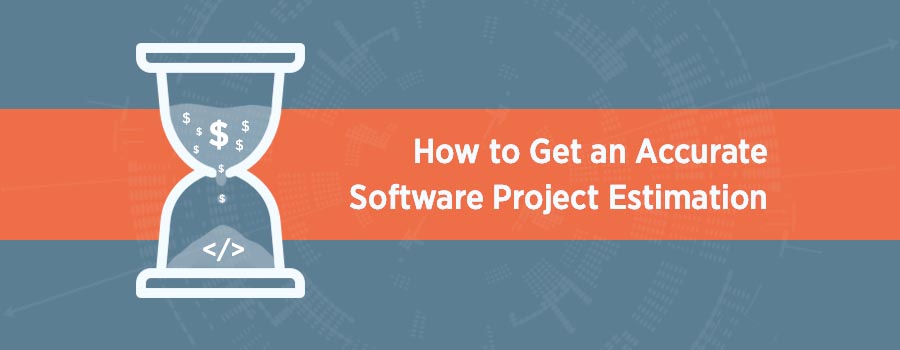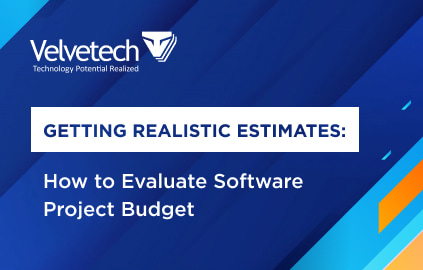A decision in favor of any IT initiative starts with an estimation. However, getting a realistic software development project estimation can be challenging.
Despite the fact that responsibility for the numbers provided in the estimate rests with your dev team or software development partner, both you and your vendor are in charge of its accuracy.

Of course, everything goes beyond just having an idea and money to support it. You must be able to express the project idea to the estimators, cast their vision, and plot the vector of the project evolvement. There are several considerations to make so as to avoid errors and other forms of consequences that are generally not palatable.
Project Estimates
Watch our webinar to learn about the practical ways to evaluate your software project estimates.
Three Pillars of Project Estimation
Before getting to the tips themselves, let’s talk about the key components you should know in order to understand how to plan your project. There are actually many elements that make a good estimation, however, we’ll take a close look at the key three. They form the ground for effective project management and provide stakeholders with a roadmap to navigate through the development lifecycle.
Time
Time is all. It’s no wonder that accurate time planning enables your development team to manage tasks effectively and meet deadlines. And that often impacts the overall outcomes.
You may naturally wonder how to estimate project time. Well, the easiest would be turning to an expert judgment. However, you may do it yourself, using one of the techniques like bottom-up, parametric, three-point, or analogous methods. In fact, there are many more of them.
Time estimation of software development initiatives should also include factors such as team expertise, project complexity, and potential risks. When you have a skilled team on board, most likely it will need less time to deliver a solution. Similarly, the more complex your endeavor is, the more time it will take.
Cost
While all three components we’re mentioning here are equally important, it’s usually the cost that business owners want to find out in the first place. And we understand that. Eventually, a project budget is all about the financial resources required to build a solution successfully.
Basically, the cost will always encompass team rates, software and hardware expenses, and sometimes indirect costs like overheads. Same as with time, it requires a detailed analysis of requirements and potential risks.
Scope of Work
Finally, there’s the scope of work, which is essential for understanding the breadth and depth of a project. It outlines the desired features, functionalities, and deliverables and guides the development team along the way while ensuring you get what you expect.
All three variables — time, cost, and scope — are interconnected. For example, any changes to software development scope impact time and cost estimation. On the other hand, if you decide to accelerate project delivery, then most likely, you’ll need to adjust the scope or increase the budget.
Besides this triangle, one should always consider potential risks. When approaching an experienced vendor, you’ll surely see contingency planning as a separate line in the ballpark estimate.
Practical Tips for Project Stakeholders
Next, we’ll shed light on some practical tips that can be used when you are putting together a software development project estimation. These tips will help you learn what to expect during a conversation with a potential tech partner or your team, understand the time estimation of software development, and finally avoid reviewing the budget repeatedly.

1. Highlight Your Goals
Implementing your tech idea goes with stating your goals and commitments in writing. Have that in mind immediately after conceiving the idea for the project.
Your objectives in the form of goals and commitments must coincide with the pressing needs of your business. You should also set a time vision as when you want your goal to be achieved. This will help you assess if the business aim of the project is attainable considering the goals and time.
2. Have a Thought-Through Vision and Set of Requirements
A detailed requirements specification should be a document that contains requirement analysis, interface prototypes, competitor analysis, use cases, target users, etc. In other words, it reflects the exact vision of the expected product. The detailed specification enables the provision of a relatively fixed price and allows you to envisage any risks.
The absence of a documented project requirements specification leaves you with two options:
The first is creating a specification with the help of your development partner. You will need to provide them with all the available materials and have a set of discovery meetings and consultations. Review and discuss the delivered specifications to make sure you are on the same page.
The second option is managing a project with an agile development approach on a time and materials basis. Be aware that it can be a wild goose chase especially if you are not working with a trusted IT vendor. Without the initial documentation, an inexperienced team can spend a lot of time and budget while making changes in the course of the project.
3. Consider the Non-Functional Requirements
Non-functional specifications serve a different use compared to the functional requirements that usually describe ‘what’ a system needs to perform. It is vital to consider the non-functional requirements, which expatiate ‘how’ the system should work.
Read about the Difference Between Functional and Non-Functional Requirements
With special reference to the nature of a project or business, non-functional requirements may have a different level of importance and relevance. Adopting non-functional requirements may also depend on the complexity of implementation.
A typical list of non-functional requirements may include such aspects as scalability, performance, high availability, security, usability, interoperability, and maintainability. Be ready to cover all these issues when discussing the project with your software development partner. They are crucial for project planning and can significantly affect the estimation.
4. Collect and Compare Estimates from Various Sources
It’s in your interest to get bids for your project from different sources. There will always be different prices and timelines in the estimates you receive. However, the shortest timeline or most expensive doesn’t translate to the best.
Your final choice of vendor based on estimation must be well considered and justified. You should make a comparison of factors that have led to the estimated total such as:
Human resources: How many programmers you will need and what is their skill level?
Technology: What is the sophistication of technology required for development?
Work/Time frame: How long it will take to complete the project and what is expected to be done?
5. Discuss the Assessment of the Project
The estimation resulting from the discovery sessions should be discussed with the team that provides it. It can be revisited to suit your expenses or meet the deadlines.
Decide with the team on what you can alter. You can both reach an agreement based on what is a priority and necessity as regards tasks for the project. A popular method of realizing this is the MoSCoW developed by Dai Clegg of Oracle UK in 1994.
MoSCoW simply means:
M – Must have this requirement to meet the business needs
S – Should have this requirement if possible, but project success does not rely on it
C – Could have this requirement if it does not affect anything else
W – Would like to have this requirement later, but delivery won’t be this time
6. Opt for a Team with the Relevant Experience
To avoid any errors or issues, you should engage the services of a vendor experienced in the nature of your project. This will help you have a more realistic estimate as all the necessary assessments and considerations will be included.
A skilled team will be of great value if you have no requirements at all. In this case, the team will guide you through the requirements definition process and finally come up with a befitting estimation.
7. Compare Man-Hours vs. Project Time Frame
This is a ratio that has a direct effect on the total software development cost. You have to consider how soon you want the project to be ready. If you want it to be fast, then there should be more hands on the project, and that will increase man-hours and result more cost.
A competent vendor with a skillful team might not necessarily need more man-hours as competence will regulate working speed. This way, you will need less time to complete a solution.
8. Keep in Mind Project Risks
All the projects of software production have risks involved and so they should be well analyzed. Mostly, software vendors include expenses to cover the risks in the estimation. Be sure to discuss possible risks with your vendor.
For example, the choice of third-party integrations can be a risk factor. Another form of risk is not adhering to regulatory policies relating to your industry. All risks must be considered in the estimation to make sure the project plan and delivery eventually work out fine.
Learn more: Top 7 Methods to Estimate Software Development Project
Business Analysis in IT
Explore the best business analysis practices and techniques to bridge the gap between a project vision and IT execution.
Velvetech’s Approach to Estimating Software Projects

Comprehensive Discovery Phase
The initial process at Velvetech is the discovery phase. It is a meeting between the expert team and the project stakeholders. The main objective of this session is to get a high-level understanding of the project. This can take more than one session depending on how how complex your endeavor is or how many details you can provide during the first session.
We get insight into the owners’ business, its goal, strategy, and operation process. This is achieved through specific target questions. During the discovery phase, we collect all your project requirements and details. This helps us provide an accurate outlook of the cost and timeline, and create a competitive estimation.
The discovery session at Velvetech is irrespective of available project requirement documentation. For establishing a level of trust this session is preceded by signing a non-disclosure agreement (NDA) with a client.
Essentially, we do the following:
- High-level vision of the project
- Identification of your business goals
- Discussion of project documentation
- Elicitation of key features of your solution
- Detailing scope of work
Detailed Estimate
This is the last phase preceded by internal deliberations. Our team meets with the client and reports the estimate. It is usually a ballpark estimation or a range. We provide a detailed cost breakdown and explain the nuances that matter.
Velvetech is staffed with well-qualified specialists who facilitate the discovery process and provide realistic estimates. Our team gives the appropriate consultations to help clients achieve their goals within a fair price and guaranteed project delivery. Learn more about our software development services and contact us for a consultation.
































